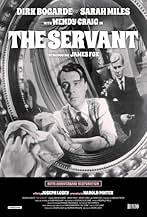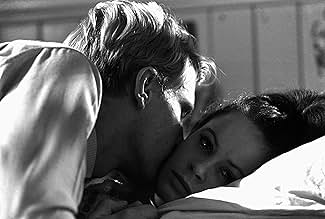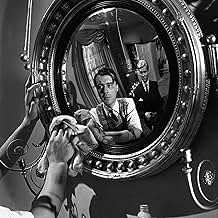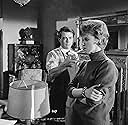IMDb-BEWERTUNG
7,8/10
15.017
IHRE BEWERTUNG
Tony aus der Oberschicht stellt den Diener Hugo Barrett ein, der, wie sich herausstellt, eine versteckte Absicht hat.Tony aus der Oberschicht stellt den Diener Hugo Barrett ein, der, wie sich herausstellt, eine versteckte Absicht hat.Tony aus der Oberschicht stellt den Diener Hugo Barrett ein, der, wie sich herausstellt, eine versteckte Absicht hat.
- 3 BAFTA Awards gewonnen
- 8 Gewinne & 11 Nominierungen insgesamt
Doris Nolan
- People in restaurant: Older Woman
- (as Doris Knox)
Empfohlene Bewertungen
This is a superb, sinister movie of the very highest class. Unlike the character Tony (James Fox) who is upper class without being high class, if you get my drift. You cannot really sympathise with Tony, who toys with some high falutin' development projects but basically is a wastrel just waiting to be ponced off. Tony is a later-day Bertie Wooster. The sinister element comes from the servant (Dirk Bogarde), who is no Jeeves. Barrett, like Jeeves , is a gentleman's gentleman or valet (not a butler as suggested in some other comments on this film). Tony needs a valet because he is incapable of doing anything much without help. Barrett and his accomplice Vera (Sarah Miles) take Tony to the cleaners, sweeping aside the fiancee Susan (Wendy Craig) in their wake.
Harold Pinter has written the screenplay in similar vein to the superb movie The Accident, also a Losey piece, which I also commend. The cinematography in both movies is simply excellent. The subject matter of The Servant suits Pinter, although much of the screenplay is not really in Pinter's voice. However, there is one scene, set in a restaurant, which includes a tiny cameo by Pinter himself and which contains a short Pinteresque exchange between two women. There is also one tense exchange between Susan and Barrett "do you wear deodorant" etc. which is very reminiscent of a scene in The Caretaker "you stink from arsehole to Thursday" etc. Indeed the story of The Servant resembles The Caretaker in many respects, except that in The Servant the interloper, Barrett, is on top and stays there, whereas in The Caretaker the interloper, Davies, lacks the skill and circumstances to dislodge the incumbent.
There is a homoerotic undercurrent to the film and this works so well because it is an undercurrent (in 1963 there could have been no more than an undercurrent even if they had wanted more). The overt debauchery with Vera and the orgy party towards the end of the film is the only bit of the film that has aged without grace. But I quibble.
This is a truly great film and it deserves to be more widely known.
Harold Pinter has written the screenplay in similar vein to the superb movie The Accident, also a Losey piece, which I also commend. The cinematography in both movies is simply excellent. The subject matter of The Servant suits Pinter, although much of the screenplay is not really in Pinter's voice. However, there is one scene, set in a restaurant, which includes a tiny cameo by Pinter himself and which contains a short Pinteresque exchange between two women. There is also one tense exchange between Susan and Barrett "do you wear deodorant" etc. which is very reminiscent of a scene in The Caretaker "you stink from arsehole to Thursday" etc. Indeed the story of The Servant resembles The Caretaker in many respects, except that in The Servant the interloper, Barrett, is on top and stays there, whereas in The Caretaker the interloper, Davies, lacks the skill and circumstances to dislodge the incumbent.
There is a homoerotic undercurrent to the film and this works so well because it is an undercurrent (in 1963 there could have been no more than an undercurrent even if they had wanted more). The overt debauchery with Vera and the orgy party towards the end of the film is the only bit of the film that has aged without grace. But I quibble.
This is a truly great film and it deserves to be more widely known.
I first watched Losey's most famous work - but not quite his best, in my opinion - on the big-screen at London's National Film Theatre in 1999, just a few months after star Dirk Bogarde's death; it's certainly one of the latter's most significant roles (along with the homosexual composer of DEATH IN VENICE [1971], perhaps his most representative), though I still feel that VICTIM (1961) is the finest film he's ever been associated with!
Even so, Bogarde's performance (recipient of the BAFTA award) is understated most of the time - which rather suits his enigmatic title character, a self-described "gentleman's gentleman" but actually harboring sinister ambitions. Interestingly, when Joseph Losey fell ill in mid-production, the directorial chores were thrust into the hands of the leading man until his recovery - who, amusingly, initially turned Losey down by saying that he "couldn't direct a bus" if his life depended on it!
While he was still some years away from the deliberate formalism that virtually characterized all his later output, Losey's style is here more controlled - for lack of a better word - than in, say, THE CRIMINAL (1960) or EVA (1962); this may have been due to the 'failure' of the latter (see my review elsewhere), or perhaps his collaboration with screenwriter (and influential playwright) Harold Pinter may have had more to do with this than anything else. Still, Douglas Slocombe's sleek black-and-white cinematography (also a BAFTA award winner) of the gloomy London settings - abetted by Johnny Dankworth's wistful score - is certainly among the film's most notable assets.
James Fox's fine performance as the usurped master of the house led him to short-lived stardom (and even copped the young actor the "Most Promising Newcomer" award at the BAFTAs); his career went on an extended hiatus some years later (which ended in the mid-Eighties) following his traumatic experience on the set of PERFORMANCE (1970), curiously enough a film dealing with a similar role-reversal situation! Though the women are subservient to the central relationship between Bogarde and Fox, both Sarah Miles and Wendy Craig serve their characters well; especially interesting is the battle of wits between the latter (as Fox's upper-class girlfriend) and Bogarde, whom she mistrusts from the get-go and is obviously proved right beyond her wildest imagination!
For a two-hour dialogue-driven film, the plot is pretty sparse - typically of Pinter, dealing in symbolism rather than presenting a straightforward narrative (despite being based on a novel by Robin Maugham) - but the tension between the various characters holds the viewer's attention all the way...though the final descent into depravity and degradation comes off as rather too abrupt and now seems more farcical than shocking (as it must have seemed at the time)! The cast also includes bit parts by two alumni of Losey's THE CRIMINAL - co-star Patrick Magee and screenwriter Alun Owen, sparring amusingly as a couple of clergymen in a bar! - as well as Pinter himself (a former actor in his own right, appearing as a 'society man' in the same scene, actually one of the very few set outside Fox's mansion).
There's a hilarious scene in which James Fox goes with Wendy Craig to visit her "mummified" high society parents. This enables Bogarde and Miles to live it up at the house during their absence. However, they cut short their visit and catch them romping about in their master's bedroom, whereupon he sacks them on the spot. This leads to the film's best scene, in my opinion: the chance meeting in a bar between Bogarde and Fox (who has, in the interim, fallen on hard times) where the Mephistophelean Bogarde paints a pitiful picture of himself which, inevitably, leads the lonesome Fox to engage his services once more. The way Losey shoots this marvelous sequence is masterly - with a minimum of camera movement and the actors strategically placed within the frame.
Trivia note: I own a British periodical from the early 80s called "The Movie" - a collection of essays strung together more or less by theme and running for an impressive 158 volumes - in which THE SERVANT was among the films chosen for a two-page critical evaluation, accompanied by a detailed synopsis and illustrated by numerous stills; I've leafed through it and read the review (written by Derek Prouse) so many times that these images from the film have become fixed in my mind and, as I lay watching, I was actively looking out for each one of them!
Even so, Bogarde's performance (recipient of the BAFTA award) is understated most of the time - which rather suits his enigmatic title character, a self-described "gentleman's gentleman" but actually harboring sinister ambitions. Interestingly, when Joseph Losey fell ill in mid-production, the directorial chores were thrust into the hands of the leading man until his recovery - who, amusingly, initially turned Losey down by saying that he "couldn't direct a bus" if his life depended on it!
While he was still some years away from the deliberate formalism that virtually characterized all his later output, Losey's style is here more controlled - for lack of a better word - than in, say, THE CRIMINAL (1960) or EVA (1962); this may have been due to the 'failure' of the latter (see my review elsewhere), or perhaps his collaboration with screenwriter (and influential playwright) Harold Pinter may have had more to do with this than anything else. Still, Douglas Slocombe's sleek black-and-white cinematography (also a BAFTA award winner) of the gloomy London settings - abetted by Johnny Dankworth's wistful score - is certainly among the film's most notable assets.
James Fox's fine performance as the usurped master of the house led him to short-lived stardom (and even copped the young actor the "Most Promising Newcomer" award at the BAFTAs); his career went on an extended hiatus some years later (which ended in the mid-Eighties) following his traumatic experience on the set of PERFORMANCE (1970), curiously enough a film dealing with a similar role-reversal situation! Though the women are subservient to the central relationship between Bogarde and Fox, both Sarah Miles and Wendy Craig serve their characters well; especially interesting is the battle of wits between the latter (as Fox's upper-class girlfriend) and Bogarde, whom she mistrusts from the get-go and is obviously proved right beyond her wildest imagination!
For a two-hour dialogue-driven film, the plot is pretty sparse - typically of Pinter, dealing in symbolism rather than presenting a straightforward narrative (despite being based on a novel by Robin Maugham) - but the tension between the various characters holds the viewer's attention all the way...though the final descent into depravity and degradation comes off as rather too abrupt and now seems more farcical than shocking (as it must have seemed at the time)! The cast also includes bit parts by two alumni of Losey's THE CRIMINAL - co-star Patrick Magee and screenwriter Alun Owen, sparring amusingly as a couple of clergymen in a bar! - as well as Pinter himself (a former actor in his own right, appearing as a 'society man' in the same scene, actually one of the very few set outside Fox's mansion).
There's a hilarious scene in which James Fox goes with Wendy Craig to visit her "mummified" high society parents. This enables Bogarde and Miles to live it up at the house during their absence. However, they cut short their visit and catch them romping about in their master's bedroom, whereupon he sacks them on the spot. This leads to the film's best scene, in my opinion: the chance meeting in a bar between Bogarde and Fox (who has, in the interim, fallen on hard times) where the Mephistophelean Bogarde paints a pitiful picture of himself which, inevitably, leads the lonesome Fox to engage his services once more. The way Losey shoots this marvelous sequence is masterly - with a minimum of camera movement and the actors strategically placed within the frame.
Trivia note: I own a British periodical from the early 80s called "The Movie" - a collection of essays strung together more or less by theme and running for an impressive 158 volumes - in which THE SERVANT was among the films chosen for a two-page critical evaluation, accompanied by a detailed synopsis and illustrated by numerous stills; I've leafed through it and read the review (written by Derek Prouse) so many times that these images from the film have become fixed in my mind and, as I lay watching, I was actively looking out for each one of them!
Back in the late 1960's or early 70's I discovered this creepy psychological drama on local late-night TV. Once seen, it's never quite forgotten, and it's fascinating to see it once again beautifully restored and uncut in its new DVD release. Aspects of it stick with you years later, most especially the dark, moody torch song with some bizarre lyrics which is played repeatedly throughout the story on Mr. Tony's record player, seeming more sinister with each successive playing. By the time of its final hearing near the end of the movie, its effect is so oppressive that it's a relief when the record player is violently shoved off the table. One telling detail is in the scene where Mr. Tony is left alone after Barrett and Vera are expelled from the house, and his fiancee Susan also disappointedly leaves him. He dejectedly goes to an upstairs bedroom, and on the wall above the bed we see pictures of male body-builders.
The cast is uniformly excellent. This was apparently James Fox's film debut, as his credit indicates `Introducing James Fox.' He was obviously an experienced actor, though. In contrast, four years later he was affecting an American accent, singing and dancing, and amazingly, looking even younger in `Thoroughly Modern Millie.'
This is the sort of role that I always associate Dirk Bogarde with. The way Barrett's malevolent character is gradually revealed, not just through the script, but through Bogarde's facial expressions and body language, is a credit to this great actor's skill. This is one dangerous guy.
`The Servant' is a real gem of early 60's British film.
The cast is uniformly excellent. This was apparently James Fox's film debut, as his credit indicates `Introducing James Fox.' He was obviously an experienced actor, though. In contrast, four years later he was affecting an American accent, singing and dancing, and amazingly, looking even younger in `Thoroughly Modern Millie.'
This is the sort of role that I always associate Dirk Bogarde with. The way Barrett's malevolent character is gradually revealed, not just through the script, but through Bogarde's facial expressions and body language, is a credit to this great actor's skill. This is one dangerous guy.
`The Servant' is a real gem of early 60's British film.
While this little known British classic has been badly neglected for the last thirty years or so, it shouldn't be; it is one of the most expertly realized portraits of British class warfare ever. Aside from Bogarde's (obviously) letter perfect portrayal of a sinister lower class valet with some ugly designs on his upper crust victim (well played also, by James Fox, who came to specialize in similar roles), one scene in particular stands out, and underlines beautifully the whole film's entire message. When Fox's aristocratic girlfriend (played by Wendy Craig) comes to visit, she has an amazing encounter with Bogarde. She suspects he's moving in on her boyfriend, ready to replace her in his affections. She imperiously orders him into the front room, abruptly quizzing him for his opinions on just about everything. She isn't concerned with his answers-she just enjoys ordering him around, Queen Victoria style. The effect is stunning-Bogarde clearly wants to strangle the bitch, but must restrain himself, he's only the servant after all. But he's still a man, and will get his revenge soon enough. The whole upper class system will be turned on its head. The resolution (if it can be called that) is not totally satisfying. In fact, it seems just as confused just and messy as life itself is.
Some reviewers have stated that Ms. Craig was miscast as the classy girlfriend. Not so-as she imperiously and hatefully orders the helpless servant around, her face and voice become a hateful mask of the arrogance and cruelty of British snobbery. A minor classic of its kind, somewhat dated, but still relevant and brilliantly filmed in moody black and white, and Bogarde's best moments on film.
Some reviewers have stated that Ms. Craig was miscast as the classy girlfriend. Not so-as she imperiously and hatefully orders the helpless servant around, her face and voice become a hateful mask of the arrogance and cruelty of British snobbery. A minor classic of its kind, somewhat dated, but still relevant and brilliantly filmed in moody black and white, and Bogarde's best moments on film.
If you watch closely you will find that not only does the internal decoration of the house change (in ways not included in the plot) to become gradually darker as Tony is gradually undermined and seduced by Barrett but also the excellent (but very much of its time) soundtrack by Johnny Dankworth & (surely - or is my recollection wrong?) Cleo Laine - though the same LP is put on the turntable many times, the arrangement of the same theme is different. (I did not notice this at first but found it pointed out in a special issue of the Oxford University magazine Isis at the time the film was released that was entirely devoted to it.) The film has recently reappeared in England as a stage work: Play without Words, seen at the National Theatre, is (was, I guess, is more accurate) a superb piece of dance theatre in which the ambiguities of the characters' motivations, or the discrepancies between their thoughts and actions, are portrayed by having more than one dancer per character. Sometimes only one is seen, sometimes they move in unison, sometimes in separate ways. It is extremely effective.
Wusstest du schon
- WissenswertesWhen producer and director Joseph Losey was hospitalized with a brutal case of pneumonia for two weeks during this shoot, Dirk Bogarde continued filming assisted by minute, daily instructions over the phone from Losey's hospital bed. When Losey returned to the set, he did not re-shoot any of the script, much to the relief of cast and crew. Bogarde managed to keep the film on schedule, though he later said the experience made him determined never to direct.
- PatzerWhen Tony and Susan arrive at Tony's house in the Mercedes, with an extended visit in mind, they both go into the house and Tony leaves the car's lights on.
- Zitate
Hugo Barrett: I'll tell you what I am. I'm a gentleman's gentleman, and you're no bloody GENTLEMAN!
- VerbindungenFeatured in Stairs (1986)
Top-Auswahl
Melde dich zum Bewerten an und greife auf die Watchlist für personalisierte Empfehlungen zu.
- How long is The Servant?Powered by Alexa
Details
- Erscheinungsdatum
- Herkunftsland
- Sprache
- Auch bekannt als
- El sirviente
- Drehorte
- Produktionsfirma
- Weitere beteiligte Unternehmen bei IMDbPro anzeigen
Box Office
- Bruttoertrag in den USA und Kanada
- 45.522 $
- Eröffnungswochenende in den USA und in Kanada
- 7.859 $
- 28. Juli 2013
- Weltweiter Bruttoertrag
- 75.720 $
- Laufzeit1 Stunde 56 Minuten
- Farbe
- Seitenverhältnis
- 1.66 : 1
Zu dieser Seite beitragen
Bearbeitung vorschlagen oder fehlenden Inhalt hinzufügen


































